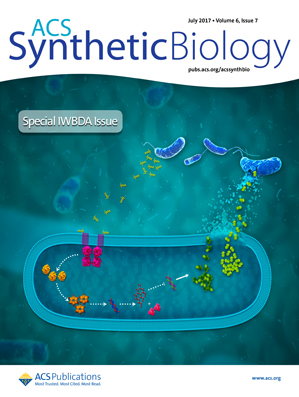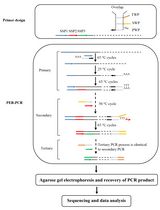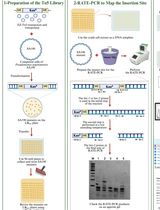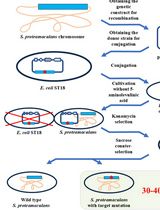- EN - English
- CN - 中文
Targeted Genome Editing of Virulent Phages Using CRISPR-Cas9
使用CRISPR-Cas9对烈性噬菌体进行靶向基因组编辑
发布: 2018年01月05日第8卷第1期 DOI: 10.21769/BioProtoc.2674 浏览次数: 16659
评审: Modesto Redrejo-RodriguezRajesh ThippeshappaAnonymous reviewer(s)
Abstract
This protocol describes a straightforward method to generate specific mutations in the genome of strictly lytic phages. Briefly, a targeting CRISPR-Cas9 system and a repair template suited for homologous recombination are provided inside a bacterial host, here the Gram-positive model Lactococcus lactis MG1363. The CRISPR-Cas9 system is programmed to cleave a specific region present on the genome of the invading phage, but absent from the recombination template. The system either triggers the recombination event or exerts the selective pressure required to isolate recombinant phages. With this methodology, we generated multiple gene knockouts, a point mutation and an insertion in the genome of the virulent lactococcal phage p2. Considering the broad host range of the plasmids used in this protocol, the latter can be extrapolated to other phage-host pairs.
Keywords: Phage (噬菌体)Background
Phages are bacterial viruses found in abundance in every ecosystem (Suttle, 2005; Breitbart and Rohwer, 2005) and unsurprisingly, they are natural inhabitants of milk. Phage p2 is a model for the most prevalent group (Sk1virus) of virulent lactococcal phages found in the dairy industry (Deveau et al., 2006; Mahony et al., 2012) and it infects the Gram-positive bacterium Lactococcus lactis MG1363, also a model strain for basic research. Despite the status of p2 as a reference phage, almost half of its genes encode uncharacterized proteins. Likewise, a clear majority of phage genes identified by metagenomics have no functional assignment and no homolog in public databases (Hurwitz et al., 2016; Paez-Espino et al., 2016).
One of the ways to study genes is through their modification and subsequent observation of the resulting phenotypes. Phage genomes can only be modified inside a host, in their biologically active form. Virulent phages are strictly lytic; thus, their genome never integrates into the bacterial chromosome. This adds a time constraint for the in vivo modification of their DNA, which can be manipulated only during their short infection cycle. The emergence of CRISPR-Cas research in the last decade lead to the adaptation of this natural prokaryotic defense mechanism into a powerful tool to edit the genome of a plethora of organisms and viruses, including virulent phages (Kiro et al., 2014; Martel and Moineau, 2014; Box et al., 2015; Pires et al., 2016; Bari et al., 2017; Lemay et al., 2017; Manor and Qimron, 2017; Tao et al., 2017).
Here, we detail a simple and reproducible protocol to edit the genome of phage p2 using the well-known Streptococcus pyogenes Cas9 (SpCas9) cloned into the lactic acid bacterium L. lactis MG1363 (Lemay et al., 2017). Within our laboratory, this protocol has also been successfully applied to edit the genome of a virulent phage infecting the Gram-negative E. coli (unpublished), illustrating its broad applicability.
Materials and Reagents
- Materials
- Disposable Pasteur pipettes (VWR, catalog number: 14672-200 )
- 3 mm glass beads (VWR, catalog number: 26396-508 )
Manufacturer: Walter Stern, catalog number: 100C . - 100 mm glass tubes with caps (Fisher Scientific, catalog numbers: 14-961-27 and 05-888-1A )
Manufacturer: Bal Supply, catalog number: 13144UL . - 150 mm glass tubes with caps (Fisher Scientific, catalog numbers: 14-961-32 and 05-888C )
Manufacturer: Bal Supply, catalog number: 18144CL . - 0.5 ml micro-tubes (SARSTEDT, catalog number: 72.699 )
- 1.5 ml micro-tubes (SARSTEDT, catalog number: 72.690 )
- Sterile 100 x 15 mm plastic Petri dishes (‘plates’) (VWR, catalog number: 25384-302 )
- 10 ml sterile BD Luer-LokTM Tip syringe (BD, catalog number: 309604 )
- 0.2 µm sterile PES syringe filter (SARSTEDT, catalog number: 83.1826.001 )
- 0.45 µm sterile PES syringe filter (SARSTEDT, catalog number: 83.1826 )
- Disposable Pasteur pipettes (VWR, catalog number: 14672-200 )
- Phage and bacterial strain
- Lactococcus lactis MG1363 (Félix d’Hérelle Reference Center for Bacterial Viruses, catalog number: HER1439 )
Note: L. lactis is generally recognized as a safe bacterium and all the experiments can be performed in a biosafety level 1 laboratory. - Phage p2 (Félix d’Hérelle Reference Center for Bacterial Viruses, catalog number: HER457 )
- Lactococcus lactis MG1363 (Félix d’Hérelle Reference Center for Bacterial Viruses, catalog number: HER1439 )
- Plasmids
- Enzymes
- Antarctic phosphatase (5,000 U per ml) (New England Biolabs, catalog number: M0289S )
- BsaI (10,000 U per ml) (New England Biolabs, catalog number: R0535S )
- Lysozyme (20,000 U per mg dry weight) (Thermo Fisher Scientific, catalog number: 89833 )
- Q5 DNA polymerase (2,000 U per ml) (New England Biolabs, catalog number: M0491S )
- T4 DNA ligase (1,000 U per ml) (Thermo Fisher Scientific, InvitrogenTM, catalog number: 15224017 )
- T4 polynucleotide kinase (10,000 U per ml) (Thermo Fisher Scientific, Thermo ScientificTM, catalog number: EK0031 )
- Taq DNA polymerase (5,000 U per ml) (NBS Biologicals, catalog number: 9K-001-0034 )
- XbaI (20,000 U per ml) (New England Biolabs, catalog number: R0145S )
- Antarctic phosphatase (5,000 U per ml) (New England Biolabs, catalog number: M0289S )
- Reagents
- AccuGENETM molecular biology water (Lonza, catalog number: 51200 )
- Agarose LE (Roche Diagnostics, catalog number: 11685678001 )
- BDTM BactoTM Brain Heart Infusion (BHI) (Fisher Scientific, catalog number: DF0037-17-8 )
Manufacturer: BD, catalog number: 237500 . - Calcium chloride dihydrate (CaCl2·2H2O) (Sigma-Aldrich, catalog number: C5080 )
- Chloramphenicol (Sigma-Aldrich, catalog number: C0378 )
- EDTA-Na2 (Sigma-Aldrich, catalog number: E5134 )
- Erythromycin (Fisher Scientific, catalog number: 10583315 )
- 95% ethanol (Commercial Alcohols, catalog number: P016EA95 )
- 100% ethanol (Commercial Alcohols, catalog number: P016EAAN )
- EZ-Vision® Three (VWR, catalog number: 97063-166 )
- Glacial acetic acid (Caledon Laboratories, catalog number: 1000-1-29 )
- Glucose monohydrate (Sigma-Aldrich, catalog number: 49159 )
- Glycerol (Merck, catalog number: GX0185-2 )
- Glycine (Merck, catalog number: 4810-OP )
- Granulated agar (Fisher Scientific, catalog number: BP1423-500 )
- Hydrochloric acid ( HCl) (Fisher Scientific, catalog number: 351285-212 )
- High DNA Mass Ladder (Thermo Fisher Scientific, InvitrogenTM, catalog number: 10496016 )
- 1 Kb Plus DNA Ladder (Thermo Fisher Scientific, InvitrogenTM, catalog number: 10787018 )
- Low DNA Mass Ladder (Thermo Fisher Scientific, InvitrogenTM, catalog number: 10068013 )
- OxoidTM M17 broth (Thermo Fisher Scientific, Thermo ScientificTM, catalog number: CM0817 )
- Magnesium sulfate heptahydrate ( MgSO4·7H2O) (Caledon Laboratories, catalog number: 4860-1-70 )
- Magnesium chloride hexahydrate (MgCl2·6H2O) (VWR, catalog number: BDH9244 )
- Sodium chloride (NaCl) (Anachemia, catalog number: 81708-380 )
- Primers (Table 1) (customized by Thermo Fisher Scientific, www.thermofisher.com)
Table 1. Primers used in this protocol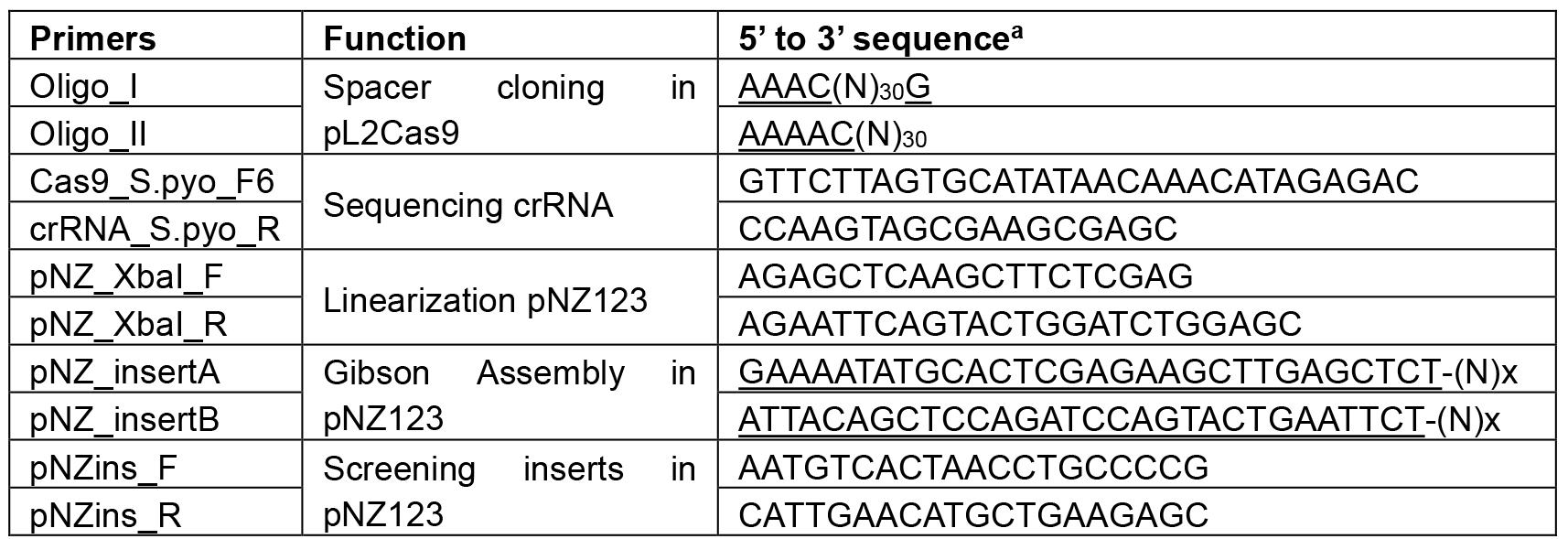
aRestriction sites for ligation and overhangs for Gibson Assembly are underlined. ‘N’ stands for any nucleotides and ‘x’ for any number of nucleotides required for the amplification of a fragment of interest. - Sodium acetate (NaAc) (Sigma-Aldrich, catalog number: S2889 )
- Sucrose (Sigma-Aldrich, catalog number: S0389 )
- Tris (Base), Ultrapure (Avantor Performance Materials, catalog number: 4109-6 )
- 0.8% and 2% agarose gel (see Recipes)
- BHI agar medium supplemented with erythromycin (see Recipes)
- BHI medium supplemented with erythromycin (see Recipes)
- 2 M CaCl2 (see Recipes)
- 10 mg/ml chloramphenicol stock solution (see Recipes)
- 10 mg/ml and 75 mg/ml erythromycin stock solution (see Recipes)
- 70% ethanol (see Recipes)
- GM17 agar medium supplemented with CaCl2 or antibiotics (see Recipes)
- GM17 medium (see Recipes)
- GM17 soft agar medium supplemented with CaCl2 (see Recipes)
- Glycine shock solution (see Recipes)
- 1 M MgCl2 (see Recipes)
- 10x Phage buffer (see Recipes)
- Recovery solution (see Recipes)
- 50x TAE buffer (see Recipes)
- Wash solution (see Recipes)
- AccuGENETM molecular biology water (Lonza, catalog number: 51200 )
- Kits
Equipment
- Autoclave
- Benchtop microcentrifuge (Eppendorf, model: 5415 D )
- Bunsen burner
- Centrifuge bottles (SS-34)
- Centrifuge Sorvall RC5C and rotor SS-34 (Thermo Fisher Scientific, catalog number: 28020 )
- Dry bath with heating block (VWR, catalog numbers: 13259-034 and 13259-130 )
- Electroporation cuvettes, 0.2 cm electrode gap (Bio-Rad Laboratories, catalog number: 1652086 )
- Gene Pulser II electroporator (Bio-Rad Laboratories, catalog number: 165-2109 )
- Incubator-shaker set to 37 °C
Note: Incubator that can be set to 30 °C (shaking not necessary) and 37 °C. - Micropipettes (Nichiryo, catalog numbers: 00-NPX2-10 , 00-NPX2-100 , 00-NPX2-1000 )
Note: Sterile filtered pipette tips to reduce contamination of the micropipettes by bioaerosols. - Microwave
- MultiDoc-ItTM Imaging System (UVP, catalog number: 97-0200-01 )
- PCR Thermal Cycler (MJ Research, model: PTC-200 )
- Power supply (Bio-Rad Laboratories, model: PowerPac 300 )
- Spectra/Por® 1 dialysis membranes, MWCO 6-8000 (VWR, catalog number: 28170-138 )
Manufacturer: Spectrum, catalog number: S632650 . - Spectrophotometer Spectronic 20D
- Tweezers
- VWR® Midi Plus 15 Horizontal Electrophoresis Systems (VWR, catalog number: 89032-296 )
Procedure
文章信息
版权信息
© 2018 The Authors; exclusive licensee Bio-protocol LLC.
如何引用
Lemay, M., Renaud, A., Rousseau, G. M. and Moineau, S. (2018). Targeted Genome Editing of Virulent Phages Using CRISPR-Cas9. Bio-protocol 8(1): e2674. DOI: 10.21769/BioProtoc.2674.
分类
微生物学 > 微生物遗传学 > DNA
分子生物学 > DNA > 诱/突变
您对这篇实验方法有问题吗?
在此处发布您的问题,我们将邀请本文作者来回答。同时,我们会将您的问题发布到Bio-protocol Exchange,以便寻求社区成员的帮助。
Share
Bluesky
X
Copy link





